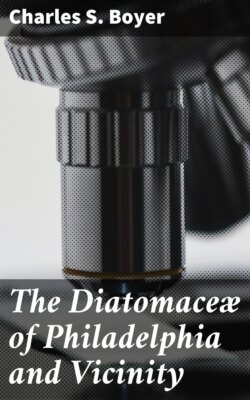Читать книгу The Diatomaceæ of Philadelphia and Vicinity - Charles S. Boyer - Страница 23
На сайте Литреса книга снята с продажи.
Pyxidicula Ehr. (1833)
Оглавление(dim. of pyxis, a box)
Frustules globular, solitary or in short fasciæ. Valve more or less hemispherical, areolate, destitute of spines.
PYXIDICULA CRUCIATA EHR.
Valve hemispherical, with large, hexagonal cells. An inner stratum is finely punctate.
Blue clay. Walnut St. Bridge. Rare.
Pl. 38, Fig. 8.
This form is not usually described as having punctate areolæ, but it does not apparently differ from other forms of Pyxidicula of Ehrenberg as described by Kuetzing (Species Algarum, pp. 21-23), including P. areolata. In fact, it differs from Stephanopyxis, which is also sometimes punctate, only in the absence of spines. In fossil deposits the absence of an easily detached stratum is not significant. The difference, except in size, between it and P. mediterranea Grun. (V. H. S., Pl. 95, Figs. 15 and 16), I am unable to determine.
Although many species of Meloseira are fresh-water, the habitat of the group Meloseirinæ is, in general, marine. It more nearly coincides in structure and development with other algæ not diatomaceous, the siliceous envelope constituting its most distinctive feature. As we proceed in the classification, the structure both of the frustule and contents becomes more complicated.
(b) COSCINODISCINÆ
1. Cyclotella.—Valve with two concentric divisions of different structure, one a wide border and the other a central surface.
2. Coscinodiscus.—Valve areolate or punctate, with a narrow border of the same structure.
